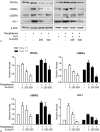Inhibitory Effects of α-Lipoic Acid on Oxidative Stress-Induced Adipogenesis in Orbital Fibroblasts From Patients With Graves Ophthalmopathy
- PMID: 26765462
- PMCID: PMC4718288
- DOI: 10.1097/MD.0000000000002497
Inhibitory Effects of α-Lipoic Acid on Oxidative Stress-Induced Adipogenesis in Orbital Fibroblasts From Patients With Graves Ophthalmopathy
Abstract
A choice of the optimal treatment for Graves ophthalmopathy (GO) is a challenge due to the complexity of the pathogenesis. Alpha-lipoic acid (ALA) is well known as a multifunctional antioxidant, helping to protect cells against oxidative stress and inflammatory damage.The aim of this study was to investigate the effects of ALA on intracellular production of reactive oxygen species (ROS), inflammation, and adipogenesis using primary cultured orbital fibroblasts from patients with GO.Intracellular ROS levels and mRNA expressions of proinflammatory cytokines and chemokines including intercellular adhesion molecule-1 (ICAM-1), interleukin (IL)-6, monocyte chemoattractant protein (MCP)-1, and regulated upon activation normal T cell expressed and presumably secreted (RANTES) were measured. After adipogenesis, the expressions of peroxisome proliferator-activated receptor (PPAR)γ, CCAAT-enhancer-binding proteins (C/EBP)α and β, and heme oxygenase-1 (HO-1) were investigated.H2O2 dose-dependently stimulated ROS production and HO-1 expression. Addition of ALA strongly attenuated ROS production and further increased HO-1 expression. However, by pretreatment of zinc protoporphyrin (ZnPP), HO-1 inhibitor, ALA inhibition of ROS generation by H2O2 was abolished. Tumor necrosis factor (TNF)α-induced mRNA expressions of ICAM-1, IL-6, MCP-1, and RANTES were inhibited by ALA treatment. In this context, TNFα-induced phosphorylation of P65 was also inhibited. In addition, ALA dose-dependently inhibited H2O2-induced intracellular accumulation of lipid droplets. The expression of adipogenic transcription factors, including PPARγ, C/EBPα, and β, was also inhibited.ALA is a potential therapeutic agent for GO because of the inhibitory effects on ROS production and gene expression of proinflammatory cytokines and chemokines, resulting in prevention of adipose-tissue expansion.
Conflict of interest statement
The authors have no conflicts of interest to disclose.
Figures





Similar articles
-
Effect of tanshinone IIA in an in vitro model of Graves' orbitopathy.Invest Ophthalmol Vis Sci. 2014 Aug 26;55(9):5900-10. doi: 10.1167/iovs.14-14008. Invest Ophthalmol Vis Sci. 2014. PMID: 25159204
-
Anti-oxidative and anti-adipogenic effects of caffeine in an in vitro model of Graves' orbitopathy.Endocr J. 2020 Apr 28;67(4):439-447. doi: 10.1507/endocrj.EJ19-0521. Epub 2020 Jan 16. Endocr J. 2020. PMID: 31941844
-
Therapeutic Effect of Resveratrol on Oxidative Stress in Graves' Orbitopathy Orbital Fibroblasts.Invest Ophthalmol Vis Sci. 2015 Oct;56(11):6352-61. doi: 10.1167/iovs.15-16870. Invest Ophthalmol Vis Sci. 2015. PMID: 26436888
-
Clinical Management and Therapeutic Strategies for the Thyroid-Associated Ophthalmopathy: Current and Future Perspectives.Curr Eye Res. 2020 Nov;45(11):1325-1341. doi: 10.1080/02713683.2020.1776331. Epub 2020 Jun 21. Curr Eye Res. 2020. PMID: 32567373 Review.
-
Current perspectives on the role of orbital fibroblasts in the pathogenesis of Graves' ophthalmopathy.Exp Eye Res. 2016 Jan;142:83-91. doi: 10.1016/j.exer.2015.02.007. Exp Eye Res. 2016. PMID: 26675405 Review.
Cited by
-
Comparative assessment of Graves' disease and main extrathyroidal manifestation, Graves' ophthalmopathy, by non-targeted metabolite profiling of blood and orbital tissue.Sci Rep. 2018 Jun 18;8(1):9262. doi: 10.1038/s41598-018-27600-0. Sci Rep. 2018. PMID: 29915201 Free PMC article.
-
Cigarette Smoke Extract-Induced Oxidative Stress and Fibrosis-Related Genes Expression in Orbital Fibroblasts from Patients with Graves' Ophthalmopathy.Oxid Med Cell Longev. 2016;2016:4676289. doi: 10.1155/2016/4676289. Epub 2016 Jun 2. Oxid Med Cell Longev. 2016. PMID: 27340508 Free PMC article.
-
The Protective Effects of Alpha-Lipoic Acid and Coenzyme Q10 Combination on Ovarian Ischemia-Reperfusion Injury: An Experimental Study.Adv Med. 2016;2016:3415046. doi: 10.1155/2016/3415046. Epub 2016 Aug 15. Adv Med. 2016. PMID: 27597986 Free PMC article.
-
PPARγ agonist through the terminal differentiation phase is essential for adipogenic differentiation of fetal ovine preadipocytes.Cell Mol Biol Lett. 2017 Mar 23;22:6. doi: 10.1186/s11658-017-0037-1. eCollection 2017. Cell Mol Biol Lett. 2017. PMID: 28536637 Free PMC article.
-
Molecular Mechanism of Stem Cell Differentiation into Adipocytes and Adipocyte Differentiation of Malignant Tumor.Stem Cells Int. 2020 Aug 12;2020:8892300. doi: 10.1155/2020/8892300. eCollection 2020. Stem Cells Int. 2020. PMID: 32849880 Free PMC article. Review.
References
-
- Korducki J, Loftus S, Bahn R. Stimulation of glycosaminoglycan production in cultured human retroocular fibroblasts. Invest Ophthalmol Vis Sci 1992; 33:2037–2042. - PubMed
-
- Bartalena L, Tanda ML, Piantanida E, et al. Oxidative stress and Graves’ ophthalmopathy: in vitro studies and therapeutic implications. Biofactors 2003; 19:155–163. - PubMed
-
- Burch HB, Lahiri S, Bahn RS, et al. Superoxide radical production stimulates retroocular fibroblast proliferation in Graves’ ophthalmopathy. Exp Eye Res 1997; 65:311–316. - PubMed
Publication types
MeSH terms
Substances
LinkOut - more resources
Full Text Sources
Other Literature Sources
Medical
Miscellaneous

